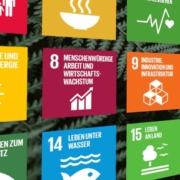Sustainable Development Goals: Drive your Organizations Change
In today’s rapidly evolving business environment, organizations are increasingly called upon to do more than just generate profits. Sustainable business practices are not just a trend – they are a global priority. At the center of this movement are the United Nations’ Sustainable Development Goals (SDGs), a set of 17 goals designed to create a better, more equitable world by 2030. These goals address urgent global challenges such as poverty, inequality, climate change, and environmental degradation. For businesses, aligning with these goals means integrating sustainability into their strategy, which in turn opens up opportunities for innovation, operational efficiency, and long-term success.
But what exactly are the Sustainable Development Goals, how can they impact your organization, and more importantly, what steps can you take today to help your organization meet these objectives? In this article, we’ll break down these questions and provide actionable insights into how you can start aligning your business practices with the SDGs.

What Are the Sustainable Development Goals?
The 17 SDGs, adopted by the United Nations in 2015, represent a comprehensive framework aimed at tackling a wide range of global issues. The goals include:
1. No Poverty
End poverty in all its forms everywhere. This goal focuses on eradicating extreme poverty, ensuring access to resources, and promoting social protection systems.
2. Zero Hunger
Achieve food security and improved nutrition, and promote sustainable agriculture. It encourages reducing hunger by supporting small-scale farmers and creating sustainable food production systems.
3. Good Health and Well-being
Ensure healthy lives and promote well-being for all at all ages. This goal highlights the need for universal healthcare access and the reduction of diseases, along with mental health initiatives.
4. Quality Education
Ensure inclusive and equitable quality education and promote lifelong learning opportunities for all. It’s about improving access to education and enhancing the quality of learning, particularly in underprivileged areas.
5. Gender Equality
Achieve gender equality and empower all women and girls. This goal aims to eliminate all forms of discrimination and violence against women while promoting equal rights in all areas of life.
6. Clean Water and Sanitation
Ensure availability and sustainable management of water and sanitation for all. It focuses on improving water quality, reducing pollution, and ensuring access to clean water.
7. Affordable and Clean Energy
Ensure access to affordable, reliable, sustainable, and modern energy for all. This goal calls for investments in renewable energy and energy efficiency to provide universal energy access.
8. Decent Work and Economic Growth
Promote sustained, inclusive, and sustainable economic growth, full and productive employment, and decent work for all. This goal is about fostering economic opportunities while ensuring safe and fair working conditions.
9. Industry, Innovation, and Infrastructure
Build resilient infrastructure, promote inclusive and sustainable industrialization, and foster innovation. The goal encourages investment in sustainable industries, innovation, and modern infrastructure to drive economic growth.
10. Reduced Inequality
Reduce inequality within and among countries. It highlights the need to close wealth gaps and promote policies that support inclusive social and economic growth.
11. Sustainable Cities and Communities
Make cities and human settlements inclusive, safe, resilient, and sustainable. This goal encourages sustainable urban planning and the development of resilient infrastructure to support growing populations.
12. Responsible Consumption and Production
Ensure sustainable consumption and production patterns. It focuses on reducing waste, using resources efficiently, and encouraging recycling and sustainable practices.
13. Climate Action
Take urgent action to combat climate change and its impacts. This goal emphasizes reducing carbon emissions, increasing climate resilience, and promoting environmental policies that address global warming.
14. Life Below Water
Conserve and sustainably use the oceans, seas, and marine resources for sustainable development. It’s about protecting marine ecosystems from overfishing, pollution, and climate change.
15. Life on Land
Protect, restore, and promote sustainable use of terrestrial ecosystems, forests, and biodiversity. This goal calls for responsible land management and efforts to combat deforestation, land degradation, and species extinction. Protecting biodiversity and halting deforestation are critical components of SDG 15. Forest ecosystems not only support countless species but also play a vital role in combating climate change. The 2030 Deforestation Goals, endorsed by global leaders, align with this effort by aiming to halt and reverse deforestation. If you want to learn more about how your organization can meet these deforestation targets, check out our article, 10 Ways Your Organization Can Meet the 2030 Deforestation Goals.
16. Peace, Justice, and Strong Institutions
Promote peaceful and inclusive societies, provide access to justice for all, and build effective, accountable institutions. It highlights the importance of good governance, transparency, and the rule of law.
17. Partnerships for the Goals
Strengthen the means of implementation and revitalize the global partnership for sustainable development. This goal calls for collaboration between governments, businesses, and civil society to achieve sustainable development.
Each of these goals includes specific targets, and while they are broad, they are designed to be implemented across different sectors – public, private, and non-profit. The SDGs encourage organizations to contribute to a better world through sustainable and responsible practices.
Sustainability isn’t just the right thing to do – it can be profitable.
Why Do the Sustainable Development Goals Matter for Your Organization?
Your business is part of a larger ecosystem, where every action has a ripple effect. By aligning with the SDGs, organizations contribute to global sustainability while enhancing their own resilience. Here’s how the SDGs impact your organization:
- Risk Mitigation: Companies that address sustainability risks – such as climate change, inequality, and resource depletion – are better positioned to mitigate potential disruptions in their operations. Investors and stakeholders are increasingly considering ESG (Environmental, Social, and Governance) factors in their decision-making.
- Operational Efficiency: Sustainable practices often lead to more efficient use of resources, reducing waste and lowering costs over time. For example, by adopting energy-efficient technologies, your company can reduce its carbon footprint while saving on energy costs.
- Reputation and Brand Loyalty: Consumers today are increasingly conscious of the ethics behind the brands they support. Companies that can demonstrate a genuine commitment to social and environmental issues can foster deeper connections with their customers and build long-term brand loyalty.
- Innovation and Market Opportunities: Aligning with the SDGs can unlock new opportunities for innovation. Companies that develop sustainable products or services can tap into growing markets driven by conscious consumerism. Sustainable development isn’t just the right thing to do—it can be profitable.
- Talent Attraction and Retention: More employees, particularly from younger generations, want to work for companies that reflect their values. Organizations that embrace sustainability can attract and retain top talent, which is increasingly seeking purposeful careers.
How to Drive Organizational Change Through the SDGs
Knowing the importance of the SDGs is just the first step. The real challenge lies in applying these principles in a way that makes a tangible impact. Here are 10 practical steps you can implement in your organization to drive your ESG initiatives forward:
1. Conduct a Materiality Assessment
Start by identifying which SDGs are most relevant to your industry and operations. A materiality assessment helps pinpoint the areas where your company can have the greatest impact. This ensures your sustainability efforts are aligned with your core business objectives.
2. Set Clear and Measurable Goals
Once you’ve identified relevant SDGs, set specific, measurable targets to track your progress. Whether it’s reducing carbon emissions, improving gender equality, or ensuring sustainable sourcing, setting defined objectives will allow your organization to stay on track.
3. Integrate ESG Into Corporate Strategy
Make sustainability part of your corporate DNA by integrating ESG principles into your business strategy. This can involve rethinking your supply chain, product development, or even how you engage with stakeholders. When sustainability is embedded into the business model, it becomes a driver for innovation and long-term success.
4. Implement Energy Efficiency Initiatives
Energy consumption is one of the easiest areas to target for immediate improvement. By implementing energy-efficient systems and renewable energy solutions, your organization can directly contribute to SDG 7 (Affordable and Clean Energy) and SDG 13 (Climate Action).
5. Reduce, Reuse, and Recycle
Promote a circular economy by rethinking your organization’s approach to waste. Prioritize the reduction of waste in production, encourage recycling programs, and seek out reusable materials. These actions directly contribute to SDG 12 (Responsible Consumption and Production).
6. Foster a Diverse and Inclusive Workplace
Creating an inclusive workplace helps achieve SDG 5 (Gender Equality) and SDG 10 (Reduced Inequalities). Build policies that support diversity in hiring, promotion, and leadership. Empower all employees by fostering a culture of equality and respect.
7. Develop Sustainable Partnerships
SDG 17 (Partnerships for the Goals) emphasizes collaboration. Look for partnerships with organizations, NGOs, or even competitors to develop solutions that tackle large-scale environmental and social issues. These partnerships can extend the reach and impact of your sustainability initiatives.
8. Support Community-Based Projects
Contributing to the community is a powerful way to demonstrate your commitment to the SDGs. Consider partnering with local organizations to support education, healthcare, or environmental protection projects in your area, contributing to SDG 4 (Quality Education) and SDG 3 (Good Health and Well-being).
9. Promote Transparency and Reporting
Stakeholders want to see tangible proof of your ESG efforts. Promote transparency by publishing regular sustainability reports. These reports should outline your progress towards meeting the SDGs and the impact of your initiatives.
10. Engage Employees in Sustainability
One of the best ways to implement change is to ensure that every employee is engaged. Provide training and resources on how they can contribute to the organization’s sustainability goals. Foster a culture where everyone is accountable for your ESG performance.
The Sustainable Development Goals are more than just lofty ideals—they offer a tangible framework that can guide your organization toward a more sustainable future.
Conclusion
The Sustainable Development Goals offer a clear roadmap for businesses to integrate sustainability into their operations. Achieving these goals isn’t just about social responsibility – it’s about building a resilient, future-proof business. By taking immediate, tangible actions today, your organization can not only contribute to a better world but also position itself as a leader in the sustainability space.
The SDGs provide a framework, but it’s up to each organization to tailor their approach. With the right strategy and commitment, your organization can turn sustainability from a challenge into an opportunity.
Looking for more in-depth guidance on integrating nature into your business strategy? Our upcoming white paper, TNFD & Biodiversity: Integrating Nature into Business Strategy, releasing on September 30th, offers comprehensive insights into aligning your organization with the Taskforce on Nature-related Financial Disclosures (TNFD) recommendations and preserving biodiversity. Opt-in for direct email communication to gain early access and get ahead on these crucial developments.



